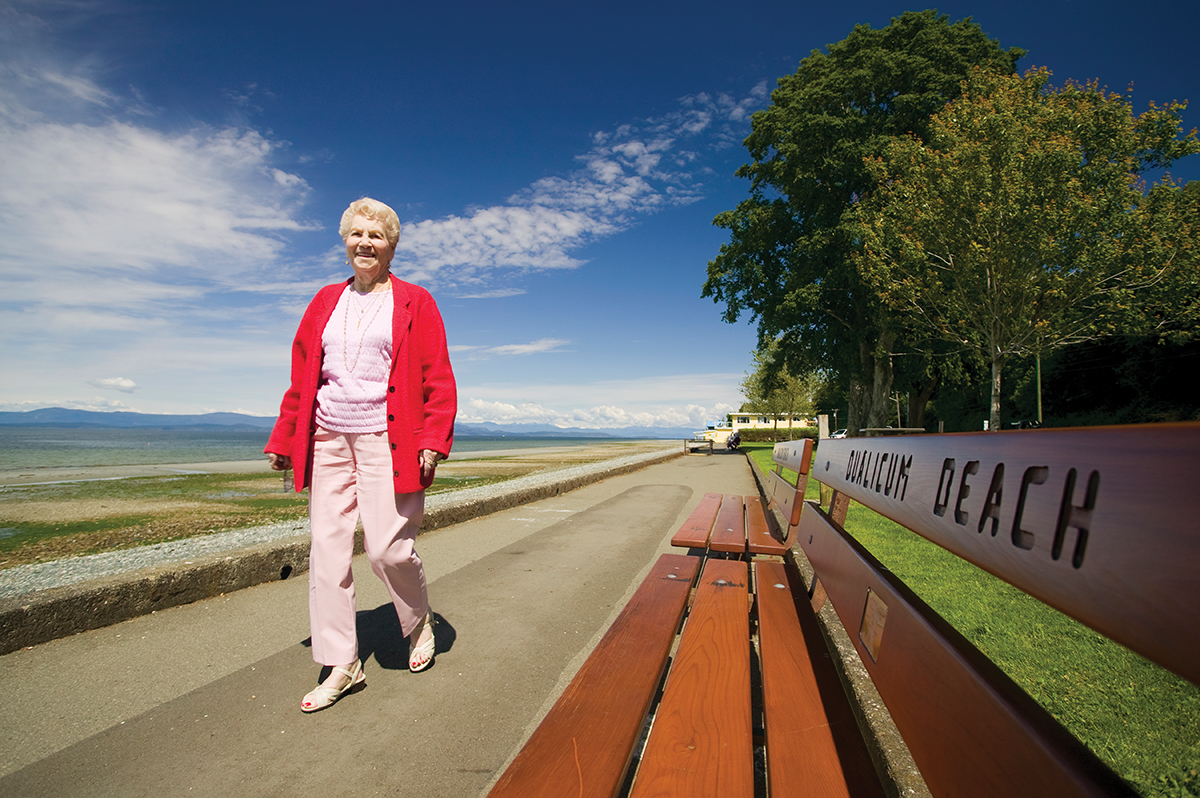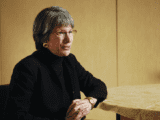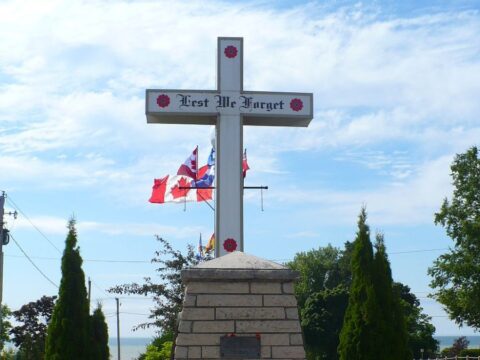It is a cool fall day when I first drive down Memorial Avenue in Qualicum Beach, a small town of 8,943 people on Vancouver Island’s eastern shore. I’m watching closely for anything on the main street that might corroborate this British Columbia community’s claim to fame: Qualicum Beach is Canada’s most elderly town.
Then, the quintessential scene materializes before me: a half-dozen seniors pushing their four-wheeled mobility walkers in single file along Second Avenue.
You may unsubscribe from any of our newsletters at any time.
The scene slips into the rear-view mirror as I head toward the water’s edge along the Strait of Georgia. But it leaves me wondering: could this town, with a whopping median age of 63.9 and a chart-topping 47 percent of its population over 65, provide a glimpse into Canada’s greying future?
My demographic group, the children of the postwar baby boom, is aging. Across Canada, that generational bulge has already raised the proportion of people aged 65 and older from eight percent in 1956 to 17 percent today. Currently, the median age in Canada is about 41 — meaning half the population is younger and the other half older.
As of July 2016, for the first time in history, the number of Canadians over 65 exceeded the number of those under age 15. By 2024, the over-65 crowd — the fastest-growing segment of the population — will make up more than a fifth of the population. We can thank good health care, nutrition and better living conditions for our increased longevity. When I was born in the early 1950s, men could expect to live to age 66 on average, and women to 71. By 2031, those figures are expected to rise to 82 and 86 respectively.
To get a sense of what life may look like in the wake of the demographic tidal wave that’s been dubbed the “silver tsunami,” I visited Qualicum Beach last fall. Thanks to a house swap with recently retired friends, my wife, Jocelyn, a retired teacher, and I lived in town for two weeks, talking to locals and sampling the life that awaits some retirees.
European settlers moved into Qualicum Beach in the late 1800s. They built a golf course in 1913, shortly after construction of the now-demolished Qualicum Beach Hotel. Other hotels, lodges and restaurants followed. Tourists and well-heeled summer residents flocked to Qualicum’s sand and pebble beaches and the warm waters of the Strait of Georgia. Summer visitors remain the town’s main economic driver.
Attracted by Qualicum’s mild winters and scenic views — coastal islands and mainland mountains to the north across the strait; Mount Arrowsmith looming in the southwest — retirees began arriving in the 1950s and ’60s. Since then, successive waves of newly retired residents have helped drive up the town’s collective age and shape its character.
As new residents, our friends admit the town sometimes seems “a bit sleepy.” But the quiet village-style atmosphere has long been seen as part of its charm and is protected by town leaders. There are no chain restaurants or franchise stores, no highrises, and virtually no industry. Parksville — its immediate neighbour to the southeast — also has beaches, tourists and retirees, but is incorporated as a city and welcomes chain stores, fast-food restaurants and industry. The median age there is high by national standards but more than four years younger than Qualicum Beach’s.
People in Qualicum Beach know their community well and don’t need Statistics Canada data to remind them of its demographic profile. At the local tourist bureau, for example, we ask a young woman if there’s a restaurant that’s a bit lively, with young people, where we might take our visiting 20-something son. The answer, delivered with a smile: “Somewhere else?”
That same self-knowledge, combined with small-town service, can also be comforting. Nicole Parton Fisher is a retired Vancouver Sun journalist who recently moved to Qualicum Beach. She tells a story about a time she took the local bus into town. When she had finished shopping, she was late arriving at the bus stop for the return trip.
“All I formerly knew about the bus was how things worked in [Vancouver] — that if you raced to the stop, missed the bus by a millisecond and banged on its closed door, the driver would pull away and ignore you,” she says. Instead, the driver saw her running to catch it, stopped down the street and waited while she boarded, then delivered her near her home without being reminded of its location. She later wrote on Facebook, “Small towns wrap their hearts around you and don’t let go.”

Ian Lindsay, a local real estate agent who moved to Qualicum Beach from Calgary more than three decades ago, says that because the town has no industry, seniors will play an increasingly important role in the local economy. It’s easy to see why they’re drawn to the area. Apart from its verdant scenery, Vancouver Island boasts the highest average winter temperatures in Canada. For active retirees, that means more mild days for biking, hiking and kayaking.
Like most small communities across Canada, Qualicum Beach is always trying to recruit more physicians. But the local health authority has a strong commitment to home care that helps seniors stay in their own homes. For other complications, it’s less than an hour’s drive to mid-sized hospitals in Nanaimo, Port Alberni and Comox; Victoria’s large hospitals are two hours away.
A welcoming nature, which seems to come naturally to most residents, is harder to quantify but nonetheless important. Retirees who make the move find a unique group ready to help them settle in: the Qualicum Beach and Area Newcomers’ Club. Founded in the early 1990s, the club offers a quick path to making new friends. Activities include weekly walking and golf outings, book and art meetings, wine and whisky tastings, monthly lunch dates, plus interest groups for downhill skiing, kayaking, motorcycling, aircraft restoration and cribbage.
The club includes about 400 members, who belong for two years and then “graduate,” either to groups they’ve created (often built around shared interests) or to one of two existing Newcomers’ alumni clubs.
I meet club president Carol Doering as she’s preparing to lead me and about 20 club members on a two-hour Friday morning trail walk that will loop between two creeks and wind up on the wheelchair-accessible, 2.5-kilometre south loop of the Lighthouse Country Regional Trail.
Doering and her husband, Doug, moved here from Jasper, Alta., three years ago, partly to help care for his aging parents living in Parksville. Accompanied by her two dogs, Doering, who is in her early 50s, sets a brisk pace. As an outdoor enthusiast, she admits that “it was maybe harder for me to find people to do things I like to do,” such as backcountry skiing or weeklong overnight hikes.
Most people come to Qualicum Beach because they dislike winter, says Doering, but she and her husband miss Jasper’s cold but often sunny winters and find coastal B.C. weather “very grey.” Still, they have made many friends in their new neighbourhood and through the Newcomers’ Club.
Fellow hiker Evelyn McGachy didn’t know anyone when she and her husband left Montreal and moved to town. Through the Newcomers’ Club and its dinner groups, she says, “We’ve met fabulous people. . . . We weren’t anywhere near as social in our hometown.”
Our time in Qualicum Beach happens to coincide with the town’s Active Aging Week, offering a dizzying array of free social and physical activities. Some are brand new to us, like lawn bowling and pickleball, a hybrid of tennis, badminton and ping-pong.
But even on a regular week, the town is brimming with adult learning opportunities. The Old School House Arts Centre offers art and photography classes, while the ECHO Players run community theatre productions. The Qualicum Beach Seniors’ Activity Centre has about 300 members and a weekly schedule that includes ukulele lessons, exercise classes and games. Golf, curling and lawn bowling clubs each offer a full rotation of organized competition and social events.
One Thursday evening, after checking out Qualicum Beach’s local museum, Jocelyn and I stroll over to the nearby Baptist church. As we stand outside, musicians begin arriving. In true Qualicum Beach fashion, a woman heading into the church asks if we want to join the musicians inside. She tells us the all-ages ensemble is the Oceanside Jammers, an informal learn-by-ear, play-by-ear group of fiddlers who meet weekly and occasionally perform publicly. All skill levels are welcome, and the only cost is a suggested $2 weekly donation, which is passed on to the congregation.
Jocelyn says she always wanted to play, but a music-teacher relative told her she was too old. “Bulls—t!” says the woman, who is well past middle age. We sit on the park bench and listen while the Jammers work through a version of Mull of Kintyre.
Despite its promises of learning and socializing, entertainment and activity, retirement can also be “an interesting crisis time,” says Rev. Phil Spencer, longtime minister at Qualicum Beach’s St. Stephen’s United. Some folks, he says, wind up “desperately golfing off into eternity.”
Spencer is not against the sport himself, but “you can only golf so much.” Some retirees show up at church looking for meaning. Like many in their generation, he says, they left church in the 1960s or ’70s and “haven’t had much to do with it since.”
The congregation is happy to help, offering a Christ-centred theology and a commitment to building discipleship. There’s weekly worship in both contemporary and traditional styles, Bible studies and occasional Alpha courses. Outreach projects include regular mission trips to visit partners in Mexico.
While staying active and busy, Spencer’s congregants do recognize their mortality, he says. “We certainly talk about death a lot here. Perhaps because we’re constantly reminded of it. We’re not a death-denying culture.”
Assisted death, he says, is “on our front burner. . . . As a local church, it’s one of the things we are going to be doing some thinking about together. How do we as Christians live faithfully in a culture where assisted suicide is an option?”
For the record, there’s no daily mobility-walker parade in Qualicum Beach. At least, I never see the Second Avenue crew again.
Seniors with walkers — often with companions — are a familiar sight on the beachside boardwalk and downtown streets. And slow-moving, sometimes wheelchair-bound elders are always part of the scene at the Saturday morning farmers’ market. But for the most part, as a group, the seniors of Qualicum Beach seem to be in great shape — physically active, socially involved and doing whatever suits them. Until time and debility take their inevitable toll, people think young.
Ian Lindsay says the town used to be seen as one of Vancouver Island’s best-kept real estate secrets. “But I think the best-kept secret is that we’re not really as old as they say we are.”














